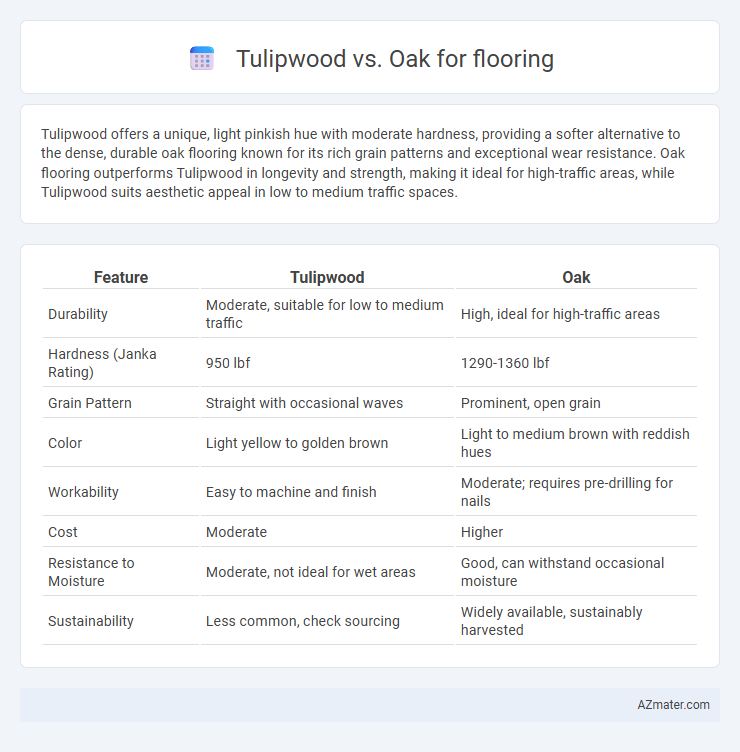Tulipwood offers a unique, light pinkish hue with moderate hardness, providing a softer alternative to the dense, durable oak flooring known for its rich grain patterns and exceptional wear resistance. Oak flooring outperforms Tulipwood in longevity and strength, making it ideal for high-traffic areas, while Tulipwood suits aesthetic appeal in low to medium traffic spaces.
Table of Comparison
| Feature | Tulipwood | Oak |
|---|---|---|
| Durability | Moderate, suitable for low to medium traffic | High, ideal for high-traffic areas |
| Hardness (Janka Rating) | 950 lbf | 1290-1360 lbf |
| Grain Pattern | Straight with occasional waves | Prominent, open grain |
| Color | Light yellow to golden brown | Light to medium brown with reddish hues |
| Workability | Easy to machine and finish | Moderate; requires pre-drilling for nails |
| Cost | Moderate | Higher |
| Resistance to Moisture | Moderate, not ideal for wet areas | Good, can withstand occasional moisture |
| Sustainability | Less common, check sourcing | Widely available, sustainably harvested |
Introduction to Tulipwood and Oak Flooring
Tulipwood flooring offers a light, creamy yellow-brown hue with subtle grain patterns, providing a modern and elegant aesthetic ideal for contemporary interiors, while being moderately durable with a Janka hardness rating around 1,210. Oak flooring, known for its rich grain texture and warm tones ranging from light tan to deep reddish-brown, boasts exceptional hardness with a Janka rating between 1,290 and 1,360, making it a popular choice for high-traffic areas. Both woods provide versatility and durability, but tulipwood's lighter color suits minimalist designs, whereas oak's robust texture complements traditional and rustic settings.
Key Differences Between Tulipwood and Oak
Tulipwood flooring offers a lighter color with a smooth, uniform grain, while oak flooring is recognized for its durability and prominent grain patterns. Oak tends to be harder and more resistant to dents, making it ideal for high-traffic areas, whereas tulipwood is softer and requires more careful maintenance. The natural color of tulipwood ranges from creamy yellow to pale green, contrasting with oak's warm reddish-brown to tan hues, influencing the overall aesthetic of interior design.
Durability and Hardness Comparison
Tulipwood flooring offers moderate durability with a Janka hardness rating of approximately 950, making it softer and more prone to dents and scratches compared to oak. Oak, particularly red and white varieties, boasts a Janka hardness between 1,290 and 1,360, providing superior resistance to wear and impact. For high-traffic areas, oak flooring delivers enhanced longevity and hardness, while tulipwood suits spaces with lighter use requiring a unique aesthetic.
Aesthetic Appeal and Color Variations
Tulipwood flooring showcases a striking, smooth grain with a creamy to golden yellow hue that deepens to a rich amber over time, offering a vibrant and warm aesthetic appeal. Oak flooring, available in red and white varieties, presents a classic look with prominent grain patterns and a wide range of color variations from light tan to deep brown, providing versatile options to match traditional or contemporary interiors. Both woods enhance flooring designs through their distinct textures and color depths, making the choice dependent on desired warmth and grain prominence.
Cost and Affordability Analysis
Tulipwood flooring typically costs between $4 and $8 per square foot, making it a more affordable option compared to oak, which ranges from $5 to $12 per square foot depending on the grade and finish. Maintenance costs for tulipwood tend to be lower due to its softer texture and easier refinishing process, whereas oak's durability may reduce long-term expenses despite higher initial investment. Budget-conscious homeowners often prefer tulipwood for cost-effective elegance, while oak is favored for its premium value and resilience.
Installation Process and Considerations
Tulipwood flooring, known for its softness and lighter weight, offers easier cutting and nailing during installation compared to the denser and harder oak. Oak flooring requires more robust tools and precise acclimation due to its tendency to expand and contract with humidity changes, impacting installation stability. Both woods demand a clean, level subfloor and moisture barriers, but oak typically involves a longer acclimation period, influencing overall project timelines.
Maintenance Requirements for Each Wood
Tulipwood flooring requires regular sealing and occasional refinishing to protect its softer grain from dents and scratches, while oak flooring boasts higher durability with less frequent maintenance due to its dense, hard grain. Oak's natural resistance to wear and moisture makes it easier to clean with simple sweeping and occasional mopping, whereas tulipwood demands more careful handling to prevent moisture damage. Both woods benefit from humidity control to prevent warping, but oak generally offers a more low-maintenance solution for high-traffic areas.
Environmental Impact and Sustainability
Tulipwood flooring offers a more sustainable option due to its faster growth rate and regional abundance compared to oak, which typically matures over several decades. Oak's longer growth cycle and higher demand contribute to greater environmental strain, including deforestation and increased carbon footprint. Choosing tulipwood supports sustainable forestry practices with lower ecological impact while maintaining durability and aesthetic appeal.
Best Applications for Tulipwood vs Oak
Tulipwood flooring is ideal for interior spaces that benefit from its rich, warm reddish-brown hue and moderate hardness, making it suitable for residential areas like living rooms and bedrooms where aesthetic appeal and comfort matter. Oak, known for its superior hardness and durability, excels in high-traffic commercial and residential settings such as kitchens, hallways, and offices, providing long-lasting wear resistance and classic grain patterns. Both woods offer unique grain textures and color variations, but Tulipwood's softness limits its use in heavy-impact environments compared to Oak's robust resilience.
Which Flooring Should You Choose?
Tulipwood offers a unique reddish hue and moderate hardness, making it ideal for homeowners seeking a warm, distinctive look with good durability. Oak, known for its strength, versatility, and classic grain patterns, provides a more traditional aesthetic and higher resistance to wear, suitable for high-traffic areas. Choosing between tulipwood and oak flooring depends on desired color palette, durability needs, and maintenance preferences.

Infographic: Tulipwood vs Oak for Flooring
 azmater.com
azmater.com